Scarface (1983 film)
7.8 /10 1 Votes
84% Rotten Tomatoes Country United States | 8.3/10 IMDb 65% Metacritic Genre Crime, Drama Duration Language English | |||||||||||||||||||||||||||||||||
 | ||||||||||||||||||||||||||||||||||
Release date December 1, 1983 (1983-12-01) (New York City)December 9, 1983 (1983-12-09) (United States) Cast (Tony Montana), (Manny Ribera), (Elvira Hancock), (Gina Montana), (Frank Lopez), Miriam Colon (Mama Montana)Similar movies Miller's Crossing , Shaft , Southland Tales , Capitalism: A Love Story , Enron: The Smartest Guys in the Room , Inside Job Tagline The world is yours... | ||||||||||||||||||||||||||||||||||
Say hello to my little friend scarface 8 8 movie clip 1983 hd
Scarface is a 1983 American crime film directed by Brian De Palma and written by Oliver Stone, a remake of the 1932 film of the same name. The film tells the story of Cuban refugee Tony Montana (Al Pacino) who arrives in 1980s Miami with nothing and rises to become a powerful drug kingpin. The cast also features Mary Elizabeth Mastrantonio, Steven Bauer, and Michelle Pfeiffer.
Contents
- Say hello to my little friend scarface 8 8 movie clip 1983 hd
- Scarface trailer hd 1983
- Plot
- Development
- Casting
- Filming
- Rating
- Release
- Reception
- Box office
- Home media
- Accolades
- Music
- Legacy
- Cancelled sequel
- Remake
- References
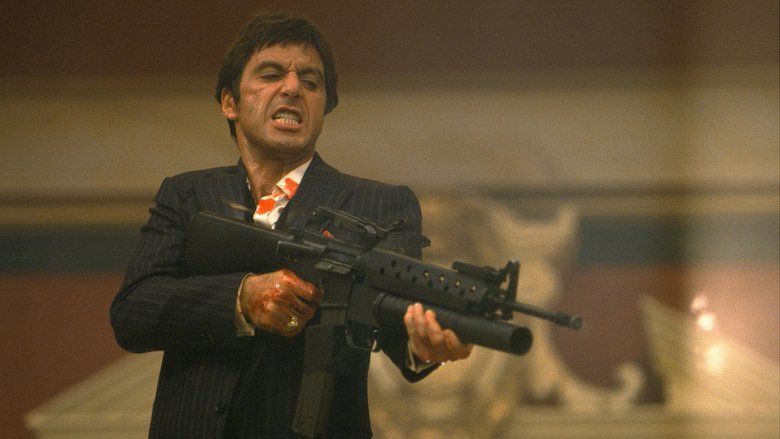
Scarface was released on December 9, 1983 and was a box office success, grossing $44 million. Initial critical reception was mixed, with criticism over excessive violence and profanity and graphic drug usage. Some Cuban expatriates in Miami objected to the film's portrayal of Cubans as criminals and drug traffickers.
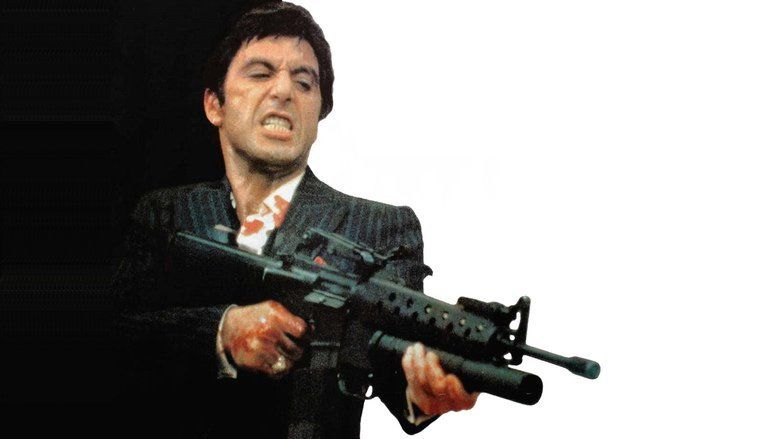
In the years that followed, the film has received reappraisal from critics, considered by some to be one of the best mob films ever made and in general. Screenwriters and directors such as Martin Scorsese have praised the film, which has been referenced extensively in pop culture, especially in rap and hip hop music as well as comic books, TV and video games. The film has long since become a cult classic.
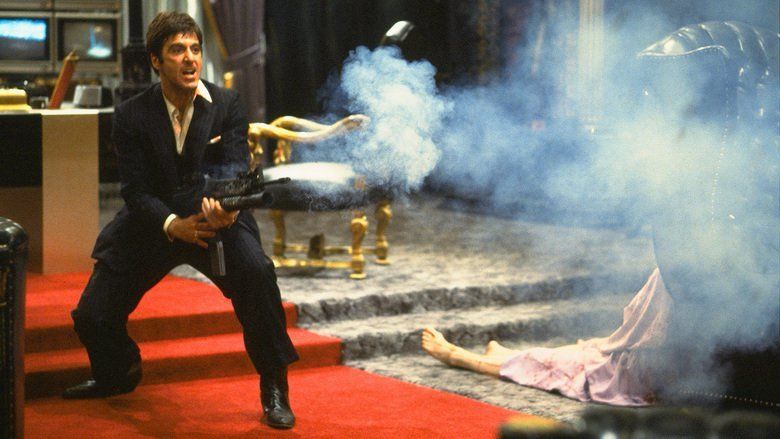
Scarface trailer hd 1983
Plot
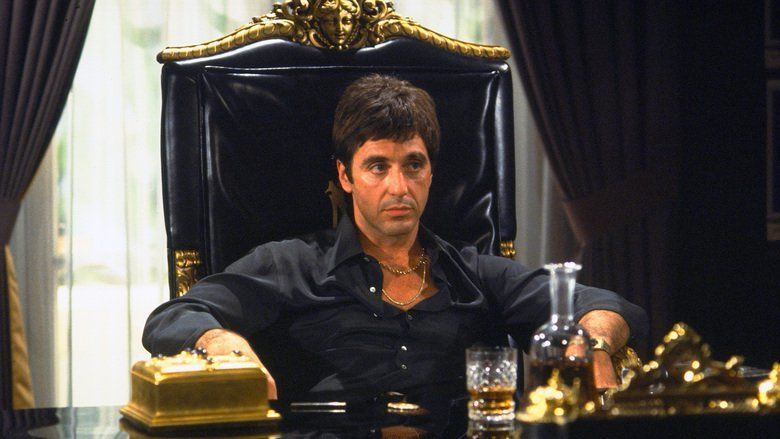
In 1980, Cuban refugee and ex-con Antonio "Tony" Montana arrives in Miami, Florida as part of the Mariel boatlift, where he is sent to a refugee camp with his best friends, Manny Ribera, Angel and Chi-Chi. The four are released and given green cards in exchange for assassinating a former Cuban government official at the request of wealthy drug dealer Frank Lopez. They become dishwashers in a diner, to Tony's disgust, proclaiming he was meant for bigger things.
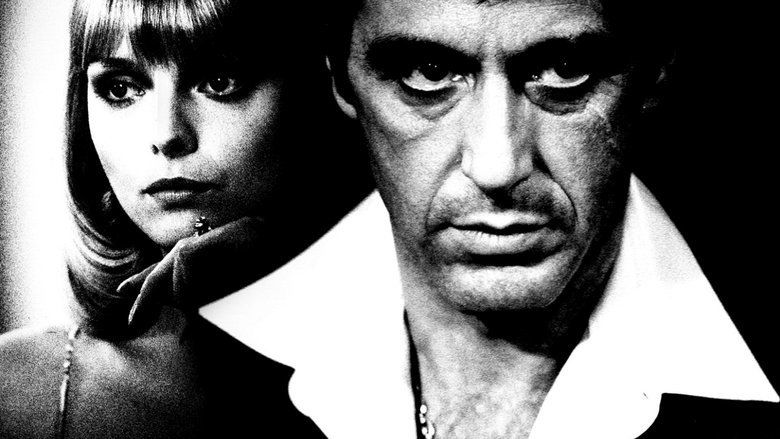
Frank's right-hand man, Omar Suarez, gives them a job: purchase cocaine from Colombian dealers, but the deal goes bad. Angel is dismembered with a chainsaw, while Manny and Chi-Chi rescue Tony and kill the Colombians. Suspecting that Omar set them up, Tony and Manny insist on personally delivering the recovered drugs and money to Frank. During their meeting, Tony is attracted to Frank's trophy wife, Elvira Hancock. Frank hires and befriends Tony and Manny.
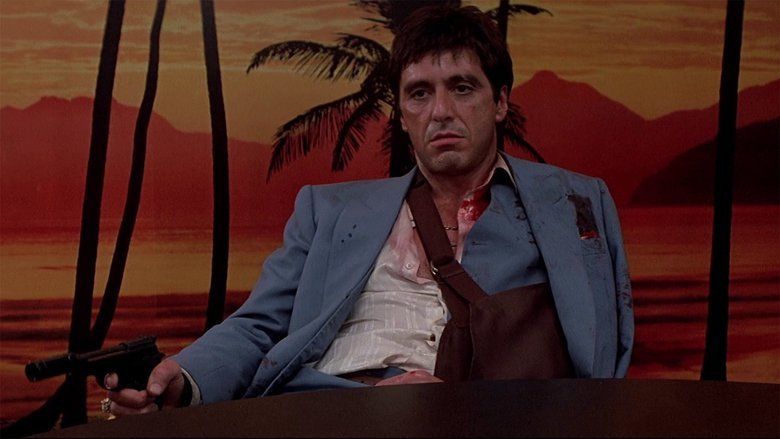
Months later, Tony visits his mother Georgina and younger sister Gina, of whom he is fiercely protective. Disgusted by his life of crime, Georgina throws Tony out. Manny is attracted to Gina, but Tony angrily tells him to stay away from her.
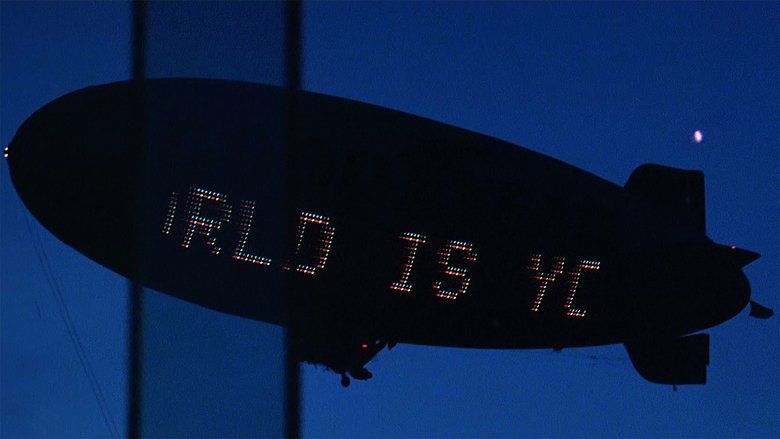
Frank sends Tony and Omar to Bolivia to meet with cocaine kingpin Alejandro Sosa. Tony negotiates a deal without Frank's approval, angering Omar, who leaves to contact Frank. Sosa claims that Omar is a police informant and that Frank is weak. Tony witnesses a beaten Omar hanged from a helicopter. Tony vouches for Frank's organization. Sosa, taking a liking to Tony, agrees to the deal, but not before warning Tony to never betray him.

Back in Miami, Frank is infuriated by Omar's demise and the unauthorized deal struck by Tony. At a nightclub, corrupt detective Mel Bernstein attempts to extort money from Tony in return for police protection and information. Tony angers Frank further by openly pursuing Elvira in the club. Spotting Gina with her boyfriend, Tony angrily beats the two of them. Hitmen attempt to assassinate Tony, but he escapes. Tony, certain that his boss sent both Bernstein and the assassins, confronts Frank, with Manny and Chi-Chi in tow. At gunpoint, Frank confesses to the attempted hit and begs for his life, but he and Bernstein are killed.
Tony marries Elvira and becomes the dealer of Sosa's supplies. He builds a multimillion-dollar empire, living in a vast, heavily guarded estate. By 1983, however, Tony becomes unsatisfied with his lifestyle and cocaine addiction. His money launderer demands a greater percentage, while Manny resents Tony's growing paranoia and abusive treatment of Elvira. A sting by federal agents results in Tony being charged with money laundering and tax evasion, with an inevitable prison sentence. Sosa offers to use his government connections to keep a desperate Tony out of prison, but only if Tony assassinates a journalist intending to expose Sosa. Later, Tony, during a public dinner, accuses Manny of causing his arrest and Elvira of being a worthless junkie, causing Elvira to leave him. He travels to New York City to carry out the assassination with Sosa's henchman, Alberto, who plants a bomb on the journalist's car. However, the journalist is unexpectedly accompanied by his wife and children. Disgusted, Tony kills Alberto and returns to Miami.
An enraged Sosa calls Tony to promise retribution. Tony, at his mother's behest, tracks down his sister, who has been sneaking out to see a man. The man turns out to be Manny, who Tony shoots in a rage. Tony returns to his mansion, where he begins a massive coke binge. While Sosa's men invade the mansion and kill Tony's men, a drugged Gina accuses Tony of wanting her for himself and attempts to kill him, but is slain by one of Sosa's men, who is in turn killed by Tony. With Tony's men all dead - including Chi-Chi - and assassins at the door, Tony turns a grenade-launcher-equipped M16A1 on Sosa's men, mowing down many. Tony is repeatedly shot, but continues to taunt until he is fatally shot from behind by a shotgun blast. His limp body falls into a fountain below, in front of a statue reading "The World is Yours".
Development
Scarface began development after Al Pacino saw the 1932 film of the same name at the Tiffany Theater while in Los Angeles. He later called his manager, producer Martin Bregman, and informed him of his belief in the potential for a remake of that film. Pacino originally wanted to retain the period piece aspect, but realized that because of its melodramatic nature it would be difficult to accomplish. Sidney Lumet became attached as the director, developing the idea for Montana to be Cuban arriving in America during the Mariel boatlift.
Bregman and Lumet's creative differences saw Lumet drop out of the project. Lumet had wanted to make a more political story that focused on blaming the current Presidential administration for the influx of cocaine into the United States, and Bregman disagreed with Lumet's views. Bregman replaced him with Brian De Palma, and hired writer Oliver Stone, later stating that it took only four phone calls to secure their involvement. Stone researched the script while battling his own cocaine addiction. He and Bregman performed their own research, travelling to Miami, Florida where they were given access to records from the U.S. Attorney's Office and the Organized Crime Bureau. Stone moved to Paris to write the script, believing he could not break his addiction while in the United States, stating in a 2003 interview that he was completely off drugs at the time "because I don't think cocaine helps writing. It's very destructive to the brain cells."
Casting
Pacino insisted on taking the lead role as Tony Montana, although Robert De Niro had been offered it and had turned it down. Pacino worked with experts in knife combat, trainers, and boxer Roberto Duran to attain the body type that he wanted for the role. Duran also helped inspire the character, who had "a certain lion in him", according to Pacino. Meryl Streep's immigrant character in Sophie's Choice (1982) also influenced Pacino's portrayal of Tony Montana. Bauer and a dialect coach helped him learn aspects of the Cuban Spanish language and pronunciation.
Pfeiffer was an unknown actress at the time, and both Pacino and De Palma had argued against her casting, but Bregman fought for her inclusion. Glenn Close was the original choice for the role, while others were also considered, including Geena Davis, Carrie Fisher, Kelly McGillis, Sharon Stone, and Sigourney Weaver.
Bauer got his role without even auditioning. During the audition process, casting director Alixe Gordin saw Bauer and instantly noted that he was right for the role of Manny, a judgment with which both De Palma and Bregman agreed. He was the only actual Cuban in the principal cast. John Travolta was considered for the role.
Filming
Pacino was injured during rehearsals for a gunfight after he grabbed the barrel of a prop gun which had just been used to fire several dummy bullets. His hand stuck to the hot barrel and he was unable to remove it immediately; the injury sidelined him for two weeks. The gunfight scene also includes a single camera shot directed by Steven Spielberg, who was visiting the set at the time. During filming, some Cuban-Americans objected to the film's Cuban-American characters being portrayed as criminals by non-Cuban-American actors. To counter this, the film features a disclaimer during its credits stating that the film characters were not representative of the Cuban-American community. The entertainment industry initially hated the film, with actress Liza Minnelli asking Pacino what he had done to leave the insiders subdued at a post-screening meal. (Minnelli had not seen the film at the time.) However, during the meal, actor Eddie Murphy told Pacino that he loved the film.
Despite its Miami setting, much of the film was actually shot in Los Angeles, as the Miami Tourist board was afraid that the film would deter tourism with its depiction of the state as a haven for drugs and gangsters. Tony's opulent Miami mansion was portrayed by El Fureidis, a Roman-styled mansion in Santa Barbara, California.
The picture was shot for 24 weeks from November 22, 1982 to May 6, 1983.
The special effects were performed by Ken Pepiot and Stan Parks.
Rating
Scarface was given an X rating in North America three times for extreme violence, frequent strong language, and hard drug usage. The restrictive rating was more associated with pornography at the time, and it both limited the number of cinemas willing to screen such a film and restricted promotional advertising, which would potentially adversely affect any box office takings. An early scene was singled out as the cause of the X rating, where Montana's associate Angel is dismembered with a chainsaw off screen. De Palma made edits to the scene and resubmitted it to the Motion Picture Association of America (MPAA), but was again given an X rating. He made further edits and resubmitted it from three to five times before refusing to further edit the film, telling Universal to either release it in its current form or fire and replace him with someone who would edit it. Universal opted to appeal the MPAA's decision. Studio president Robert Rehme attended the hearing which was presided over by his friend MPAA President Jack Valenti. Among those speaking on behalf of the film during the appeal were film critic Roger Ebert, the head of Florida's Broward County organized crime division, and the head of a major theater chain named Alan Friedberg. MPAA member Richard Heffner later admitted that he could have fought harder to retain the X rating, but he believed that Valenti did not support the decision, as he did not want to alienate the big film studios. The decision was overwhelmingly in favor of releasing the film with a less restrictive R rating.
In response, De Palma argued that, if the latest version of the film was now considered an R, then his original version would also be rated R, rationalizing that the edits which he made were minor. The MPAA told De Palma that only his latest edit would be certified as an R. De Palma believed that the changes were so slight that no one would notice if he released his original version anyway, which he ultimately did.
Release
Scarface premiered on December 1, 1983 in New York City, where it was initially greeted with mixed reaction. The film's two stars, Al Pacino and Steven Bauer, were joined in attendance by Burt and Diane Lane, Melanie Griffith, Raquel Welch, Joan Collins, her boyfriend Peter Holm, and Eddie Murphy, among others. The limited, 20th anniversary theatrical re-release in 2003 boasted a remastered soundtrack with enhanced sound effects and music.
Reception
The initial release of Scarface was met with a negative critical response, and drew controversy regarding the violence and graphic language in the film. The New York Magazine defined it as an empty, bullying, and overblown B movie.
It has been reported that Cher loved the film; Lucille Ball saw the film with her family and hated it because of its strong language and graphic violence; and Dustin Hoffman was said to have fallen asleep. Writers Kurt Vonnegut and John Irving were among those who allegedly walked out in disgust after the notorious chainsaw scene. At the middle of the film, Scorsese turned to Bauer and told him, "You guys are great – but be prepared, because they're going to hate it in Hollywood... because it's about them."
Roger Ebert rated it four stars out of four in his 1983 review, and he later added it to his "Great Movies" list. Ebert wrote, "DePalma and his writer, Oliver Stone, have created a gallery of specific individuals, and one of the fascinations of the movie is that we aren't watching crime-movie clichés, we're watching people who are criminals." Vincent Canby praised the film in the New York Times: "The dominant mood of the film is... bleak and futile: what goes up must always come down. When it comes down in Scarface, the crash is as terrifying as it is vivid and arresting."
Leonard Maltin was among those critics who held a negative opinion of Scarface. He gave the film 1½ stars out of four, stating that Scarface "wallows in excess and unpleasantness for nearly three hours, and offers no new insights except that crime doesn't pay. At least the 1932 movie moved." Maltin included an addendum to his review in later editions of his annual movie guide, stating his surprise with the film's newfound popularity as a cult-classic.
In his review for Newsweek, David Ansen wrote, "If Scarface makes you shudder, it's from what you think you see and from the accumulated tension of this feral landscape. It's a grand, shallow, decadent entertainment, which like all good Hollywood gangster movies delivers the punch and counterpunch of glamour and disgust". Jay Scott writes in his review for the Globe and Mail, "For a while, Al Pacino is hypnotic as Montana. But the effort expended on the flawless Cuban accent and the attempts to flesh out a character cut from inch-thick cardboard are hopeless." In his review for the Washington Post, Gary Arnold wrote, "A movie that appeared intent on revealing an alarmingly contemporary criminal subculture gradually reverts to underworld cliche, covering its derivative tracks with outrageous decor and an apocalyptic, production number finale, ingeniously choreographed to leave the antihero floating face down in a literal bloodbath."
Review aggregation website Rotten Tomatoes offers a contemporary interpretation of the film's reception, providing an 83% approval rating from 65 critics – an average rating of 7.5 out of 10 – with the following consensus: "Director Brian De Palma and star Al Pacino take it to the limit in this stylized, ultra-violent and eminently quotable gangster epic that walks a thin white line between moral drama and celebratory excess." Metacritic gives it an average score of 65/100.
Box office
Scarface was released theatrically in North America on December 9, 1983. The film earned $4.5 million from 996 theaters during its opening weekend, an average of $4,616 per theater, and ranking as the second-highest-grossing film of the weekend behind Sudden Impact ($9.6 million), which debuted the same weekend. It went on to earn $45.4 million in North America and $20.4 million from other markets, for a total of $65.8 million. This figure made Scarface the 16th highest-grossing film of 1983, and seventh highest grossing R-rated film in North America for 1983.
Home media
Scarface was initially released by MCA Home Video on VHS, CED Videodisc, Laserdisc, and Beta in the summer of 1984 – a two-tape set in 1.33:1 pan and scan ratio – and quickly became a bestseller, preluding its cult status. A 2.35:1 Widescreen VHS would follow years later in 1998 to coincide with the special edition DVD release. The last VHS release was in 2003 to counterpart the 20th anniversary edition DVD.
The television version of Scarface premiered on ABC on January 7, 1989. 32 minutes of violence, profanity and sex were edited out, and much of the dialogue, including the constant use of the word "fuck", which was muted after the beginning of "f-" or replaced with less offensive alternatives.
The film received a North American DVD release on the film's fifteenth anniversary in 1998 featuring a non-anamorphic widescreen transfer, a "Making of" documentary, outtakes, production notes, and cast and crew biographies. This release was not successful, and many fans and reviewers complained about its unwatchable video transfer and muddled sound, describing it as "one of the worst big studio releases out there". In 2003, a 20th anniversary re-release, featured two documentaries — including a new interview with Steven Bauer and another produced by Def Jam Recordings featuring interviews with various rappers on the film's cult status in the hip hop world.
Scarface was released on Blu-ray Disc on September 6, 2011 in a two-disc, limited edition, steelbox package. The set contains a remastered, 1080p widescreen transfer of the film in 7.1 DTS-HD Master Audio surround sound, as well as a digital copy. Disc two is a DVD of the 1932 Scarface, featuring a TMC-produced introduction by Robert Osborne and an alternate ending. Bonus features include The Making of Scarface documentary, and a new retrospective documentary: The Scarface Phenomenon.
A special gift set, limited to 1,000 copies, features the Blu-ray set housed in a cigar humidor, designed by humidor craftsman Daniel Marshall. The humidor box set retailed at $999.99.
Universal also launched a "National Fan Art Contest" via Facebook. The top 25 submissions selected by Universal were entered in a poll where fans voted on their 10 favorite works to be featured as art cards in the Blu-ray set. The Grand-Prize winner had their artwork featured on a billboard in a major US city in order to promote the release. To celebrate the release of Scarface on Blu-ray, Universal Studios and Fathom Events teamed up to make a Scarface Special Event. The event included Scarface coming back to select theaters nationwide for one night only on Wednesday, August 31, 2011. A twenty-minute documentary on how the film impacted the world today also featured..
Accolades
The film is recognized by American Film Institute in these lists:
Music
Instead of using music from the period in which the film was set, the generic music in Scarface was produced by Academy Award-winning Italian record producer Giorgio Moroder. Reflecting Moroder's style, the soundtrack consists mostly of muzak-like synthesized new wave, electronic music. De Palma says that he has repeatedly denied Universal's requests to release the film with a "pop" score because he feels that Moroder's score is adequate.
Legacy
Pacino was already an established successful actor, but Scarface helped launch Pfeiffer's and Mastrantonio's careers, both of whom were relatively unknown beforehand, and both went on to individual successes. Entertainment Weekly ranked the film #8 on their list of "The Top 50 Cult Films," and Empire Magazine placed it among the top 500 films of all time, at #284. In 2010, VH1 rated the movie at number 5 in its list of 100 greatest movies of all time. In 2009, Total Film listed it at number 9 on their list of the 30 Greatest Gangster movies. Scarface was among the earliest films in which the expletive "fuck" is used persistently, 226 times in total. The company set up by former Iraqi dictator Saddam Hussein to launder money was named Montana Management after Pacino's character.
The release of Scarface coincided with the rise of hip hop music, and the film has had a lasting influence on hip hop artists. American rapper Nas compared himself to Tony Montana and compared rapper Jay-Z to Manolo, both characters from Scarface, on Nas's track "Last Real Nigga Alive" from his album God's Son, during the time of the high-profile feud between the two.
In 2010, artist James Georgopoulos included the screen-used guns from Scarface in his popular Guns of Cinema series. Dark Horse Comics' imprint DH Press released a novel called Scarface: The Beginning by L. A. Banks. IDW publishing released a limited series called Scarface: Scarred For Life. It starts with corrupt police officers finding that Tony has survived the final mansion showdown. Tony works at rebuilding his criminal empire, similar to the game The World Is Yours.
Among other films, Scarface served as a major inspiration for the 2002 video game Grand Theft Auto: Vice City, which took place in a representation of 1980s' Miami and featured music from the film's soundtrack, as well as a recreation of Montana's mansion. Scarface got its own direct tie-in with the 2006 video games Scarface: The World Is Yours and Scarface: Money. Power. Respect..
Cancelled sequel
In 2001, plans were made for hip hop artist Cuban Link to write and star in a sequel to Scarface titled Son of Tony. The plans drew both praise and criticism and, after several years, Cuban Link indicated that he may no longer be involved with the project as the result of movie rights issues and creative control.
Remake
Universal announced in 2011 that the studio is developing a new version of Scarface. The studio stated that the new film is neither a sequel nor a remake, but will take elements from both this version and its 1932 predecessor, including the basic premise: a man who becomes a kingpin in his quest for the American Dream. Martin Bregman produced the 1983 remake and will produce this version also, with a screenplay by David Ayer, and David Yates in talks to direct the film.
On March 24, 2014, TheWrap reported that Pablo Larraín was in negotiations to direct the film, along with Paul Attanasio writing the film's script. The film's update will be an original story set in modern-day Los Angeles that follows a Mexican immigrant's rise in the criminal underworld as he strives for the American Dream. Jonathan Herman was set in March 2015 to rewrite both drafts of the script.
On August 10, 2016, Deadline.com reported that Antoine Fuqua was in talks to direct the film. On September 28, 2016, Variety reported that Terence Winter would be penning the script for the film. In January 2017, Fuqua left the project and Diego Luna was cast in the lead role. On February 10, 2017, it was announced that the film will be released in theaters on August 10, 2018, with the film's script being written by the Coen Brothers.
References
Scarface (1983 film) WikipediaScarface (1983 film) IMDbScarface (1983 film) Rotten TomatoesScarface (1983 film) MetacriticScarface (1983 film) themoviedb.org
